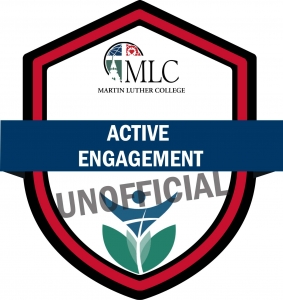MICRO-CREDENTIALS
Formal Recognition for Informal Learning
BDG0105 Active Engagement
DESCRIPTION: Teachers who earn the Active Engagement Micro-Credential engage learners in high cognition and high participation activities within a lesson to build student understanding.
EARNING THE MICRO-CREDENTIAL: To earn the Active Engagement Micro-Credential, teachers demonstrate competencies to engage all learners during lesson presentation with high participation and high cognition activities, positively affecting student learning. Earners write both a lesson plan to incorporate high participation, high cognition activities and a reflection explaining how the chosen methods are both high participation and high cognitive activities, and commenting on their effectiveness. The earner video-records the planned lesson to demonstrate competency to engage all learners actively in a lesson without detracting from the stated learning target.
RESEARCH BASE: Active engagement increases student learning with an effect size between .58 and .66, which corresponds to an increase of 25 percentile points in achievement (Dean, Hubbell, Pitler, & Stone, 2012).
BACKGROUND: Consider these resources to better understand the topic.
Himmele, Pérsida & Himmele, William (2017). Total participation techniques: Making every student an active learner. Alexandria VA: ASCD http://www.ascd.org/publications/books/117033/chapters/A_Model_for_Total_Participation_and_Higher-Order_Thinking.aspx
Jablon, J. & Wilkinson, M. (March, 2006). Using engagement strategies to facilitate children’s learning and success. YoungChildren.
Active engagement video: https://vimeo.com/180346677
MICRO-CREDENTIAL CRITERIA: An active engagement micro-credential earner can do the following:
- Plan lessons that will engage all students in high cognition, high participation activities.
- Understand the connection between active engagement and student learning.
SKILL DEMONSTRATION:
Create a lesson plan that includes the following:
- The lesson targets or objectives.
- Three different high cognition, high participation techniques to engage all students actively during the lesson presentation.
- Explanations to show the connections of the engagement techniques to higher order thinking and high student participation.
Submit a lesson video.
Keep in mind the following:
- Teach and video-record the planned lesson with special emphasis on active engagement techniques to achieve high cognition and high participation from all learners during lesson presentation.
- Obtain permission from parents or guardians for students to be video-recorded.
- Show the techniques in practice and resulting student high cognitive engagement and high participation.
- Edit the video so its total length does not exceed 15 minutes.
Submit a written reflection.
After completing the recorded lesson, write a reflection (maximum: 400 words) of the lesson that explains:
- The positive effect of the selected active engagement techniques chosen for each lesson.
- How student learning “moved beyond shallow, superficial understanding toward cognitively intense, meaningful and deep learning.” (Himmele & Himmele, p. 15)
- The change(s) that can be made to engage all students actively without detracting from learning targets.
RUBRIC:
RESOURCES:
Books
Himmele, Pérsida & Himmele, William (2017). Total participation techniques: Making every student an active learner. Alexandria VA: ASCD http://www.ascd.org/Publications/Books/Overview/Total-Participation-Techniques-Making-Every-Student-an-Active-Learner-2nd-Edition.aspx
Antonetti, John V. & Garver, James R. (2015). 17,000 Classroom visits can’t be wrong: Strategies that engage students, promote active learning, and boost achievement. Alexandria VA: ASCD http://www.ascd.org/Publications/Books/Overview/Seventeen-Thousand-Classroom-Visits-Cant-Be-Wrong.aspx
Dean, Ceri; Hubbell, Elizabeth Ross; Pitler, Howard; & Stone, Bj (2012). Classroom instruction that works: Research-based strategies for increasing student achievement. Alexandria, VA: ASCD http://www.ascd.org/publications/books/111001.aspx
Articles
Edwards, Mark A. (2013). The 6 Key Drivers of Student Engagement. T.H.E. Journal https://thejournal.com/articles/2013/04/16/the-6-key-drivers-of-student-engagement.aspx
Heath, Chip & Heath, Dan (2018). The Secret to Student Engagement. Education Week. https://www.edweek.org/ew/articles/2018/01/10/the-secret-to-student-engagement.html
Johnson, B. (2012). How do we know when students are engaged? Edutopia. http://www.edutopia.org/blog/student-engagement-definition-ben-johnson
Strong, Harvey; Silver, Harvey F.; & Robinson, Amy. (1995) Strengthening student engagement: What do students want (and what really motivates them)? Educational Leadership 53:1 http://www.ascd.org/publications/educational-leadership/sept95/vol53/num01/Strengthening-Student-Engagement@-What-Do-Students-Want.aspx
Videos
Institute for Evidence-based Reform, LLC (2015). A brief video of active student engagement in a high school biology class. https://www.youtube.com/watch?v=_WMRgYCVHrs
KinderGals (2015). A brief video of active student engagement in a kindergarten class. https://www.youtube.com/watch?v=BSlHazo3Wcc
Martin Luther College Office of Graduate Studies and Continuing Education (2016). Active engagement. https://vimeo.com/180346677
Robinson, K. (2010). Changing Education Paradigms https://www.ted.com/talks/ken_robinson_changing_education_paradigms
University of Cambridge. Active engagement techniques: Teaching for active engagement. https://www.youtube.com/watch?v=i8hMrlLkk-Y




